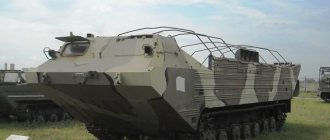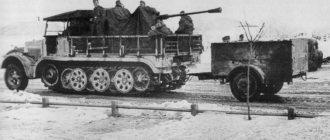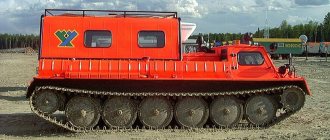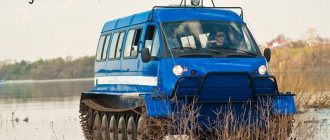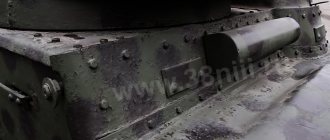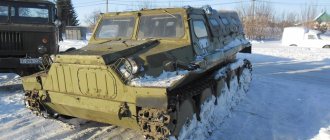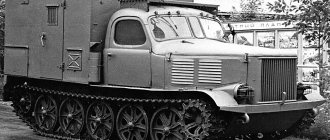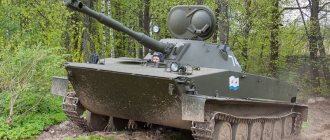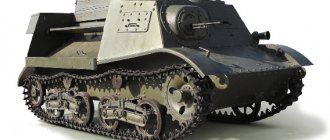The war of engines required a complete transition of troops to mechanized traction, but doing this in the conditions of the Far North turned out to be very difficult. Nevertheless, it was in our country that in the second half of the last century unique examples of all-terrain vehicles were created, which made it possible not only to develop the Arctic, but also to reliably protect it. But this technology had one annoying feature - large dimensions and weight. To a certain extent, the problem was solved by using small snowmobiles and all-terrain vehicles, but for intermediate tasks, when the “little ones” can no longer cope, and the use of larger vehicles is tactically and economically inexpedient, the necessary equipment that meets the strict requirements of the Russian Ministry of Defense was not available for a long time.
There is an urgent need for a new all-terrain vehicle capable of filling the empty niche between the “giants” and the “little ones” and providing the group of Russian troops in the Arctic with the necessary mobility. And soon such machines appeared in Russia. One of them is the GAZ-3344-20 “Aleut” tracked two-link snow and swamp-going vehicle.
GAZ-3344
GAZ-3344
GAZ-3344
GAZ-3344
The Zavolzhsky Crawler Tractor Plant, owned by the GAZ Group, has been producing all-terrain vehicles since 1973 - both for the army and for oil production, energy and other industries operating in hard-to-reach areas of our country. Until recently, the ZZGT model range included only single-link all-terrain vehicles - the newest GAZ-3344 became the first two-link. In design, it resembles the famous “Vityazi”, more precisely, the youngest of the Ishimbay models with a carrying capacity of the same two tons. Another feature of the Trans-Volga all-terrain vehicle is tracks with rubber shoes, allowing movement on the highway without damaging the asphalt. Moreover, the shoes are easily removable, and when worn, they can be replaced without removing the track. However, it is not at all necessary to do this in the field: on snow and soft ground, the boots will last until the car is overhauled, and even with regular driving on asphalt, they will cover several thousand kilometers.
Peculiarities
In addition to rescue operations, the DT-30 Vityaz is also used to deliver a variety of equipment and special equipment, such as firefighting equipment, cranes, excavators and other vehicles that are very difficult to reach independently. The machines are very widely used for military purposes, by various types of units. All thanks to the high cross-country ability. Transporters are able to overcome wide ravines and ditches, the width of which reaches up to 4 meters, and can also climb hills and slopes up to one and a half meters high.
The design of the vehicle has a number of features that distinguish the DT-30 Vityaz from the rest of the list of all-terrain vehicles. The connecting links can be folded in two planes, and this process can be controlled directly from the driver’s cab. In order for these links to move relative to each other without problems, a special rotary coupling device is provided, with two hydraulic cylinders installed for control. They can significantly improve the maneuverability of the machine, and also work on the principle of shock-absorbing elements to ensure smoother movement.
Specifications*
Technical specifications*
Technical specifications*
Specifications*
The width of the all-terrain vehicle is just over two meters (the same as, for example, the GAZelle), which provides a number of advantages. For example, on forest roads cut taking into account the width of Belarus tractors, that is, 1.6–2 m. Or when moving along a railway line: often an abandoned or active branch laid along an embankment through swamps or impassable thicket is the only way to a populated area. By the way, this is why the designers made the GAZ-3344 gauge almost equal to the five-foot railway gauge used in Russia. The Zavolzhsky two-link vehicle will comfortably ride exactly on the rails, without slipping or damaging them thanks to the rubber “shoes”, while a wide 30-ton all-terrain vehicle will be forced to roll along the slope of the embankment, risking capsizing, periodically cutting off small trees and, accordingly, shaking from blows. The power plant includes a Chinese-made Cummins 4ISBe diesel engine with a capacity of 185 hp. With. The power system is turbocharged and fuel injection at a pressure of 1800 bar from a common rail. Fuel system components are from Bosch. The gearbox is a hydromechanical 5-speed Allison 2500. The track formula is 4x4, that is, all wheel drive. Through the transfer case, torque is transmitted by cardan shafts to the axles of each link. The hulls of both links (the so-called “boats”) are hermetically welded from steel sheet, which provides the vehicle with buoyancy. The propeller on the water is the caterpillars of both links, the speed afloat is up to 6 km/h. The transmission shafts coming out of the boat's hull are sealed, and the suspension torsion bars pass inside pipes welded across. To ensure an even load on the tracks, the drive axles are located in front of each link; for the same purpose, most of the units (engine, gearbox and transfer case) are located in the front link, and the payload is carried mainly by the rear link. The two-link circuit provides a lot of possibilities that are not available to single-link machines. If the tracks of one link lack traction with the ground (for example, on a steep but short climb), it is pulled out or, conversely, pushed out by the horizontally located other. By blocking the hinge connecting the links, the hydraulic cylinders and the drawbar of both links, we get a rigid triangle - we can temporarily turn the machine into a long single-link, capable of driving over a trench three meters wide and of any depth.
Operating rules
Before driving, check the filling of fuel tanks, radiators, and oil tanks.
Leaks of process fluids that could immobilize the machine at a distance from populated areas are not allowed.
To start the V-46-5 diesel engine, compressed air is used; the modification with the YaMZ-8401 engine is equipped with an electric starter. The power plants are equipped with autonomous heaters, allowing startup at temperatures from -50°C. After starting, the engine warms up to +50...+60°C with simultaneous heating of the working fluid in the box.
To change the direction of movement, an automobile or sector-type steering wheel is used, and hydraulic cylinders are used to reduce the turning radius. In front of the driver there is an instrument panel with control indicators and control buttons. Before starting operation, it is necessary to study the purpose of instruments and indicator lamps. In the event of a drop in oil pressure in the lubrication system or in the hydraulic circuits, further operation of the DT-30 all-terrain vehicle is prohibited.
Pedals are used to control engine speed and brakes. The hydromechanical transmission switches speeds automatically; there is a lever on the steering column to select the operating mode. The steering wheel controls the side clutches, and the vehicle is turned by braking one of the caterpillar tracks. Modernized cars use turn direction indicators, which are activated by a separate lever on the steering column.
Specifications*
Technical specifications*
Technical specifications*
Specifications*
At the customer's choice, the rear link can be either purely cargo or passenger with 15 seats. Another 5 seats are provided in the front section. The price of the basic version of the all-terrain vehicle is about 6.5 million rubles, but if the customer wants to install additional equipment in the rear link, for example, a telescopic boom with a cradle for servicing power lines, a drilling rig, etc., the price will be correspondingly higher.
GAZ-3344: folding all-terrain vehicle
History of creation
Its roots go back to the distant past, when the troops of the Second Belorussian Front, on the approaches to Berlin, crossed the Oder River.
At the end of the Great Patriotic War, the USSR's ally, the USA, was armed with amphibious armored personnel carriers, and Soviet troops overcame water obstacles using old-fashioned methods, using ordinary raincoats filled with sawdust, pontoons, logs and boards.
Among the fighters crossing the Oder near Frankfurt was a young soldier, Konstantin Oskolkov. It was etched in his memory how all the weapons were carried out by the soldiers, who were chest-deep in water: machine guns, mortars and boxes of shells.
The number of dead soldiers who crossed the river is unknown to anyone. Years later, Konstantin Oskolkov, having graduated from a technical university in automotive engineering, began creating a heavy-duty all-terrain vehicle for transporting rocket launchers, as Comrade Stalin wanted.
Modifications
Due to its design, such an all-terrain vehicle has great potential for modernization, as well as increasing cross-country ability and other technical characteristics. It is possible to use “Vityazi” for the purpose of installing specialized road construction equipment on them or as a universal chassis.
Cross-country ability of Vityaz
Vityaz DT-30E
Model of an all-terrain vehicle on the basis of which excavator equipment is installed. Its purpose is to carry out land and road transport works and transport goods. This modification of the all-terrain vehicle is equipped with 3 outriggers with automatic control.
Be sure to read: Metelitsa tracked platform
The level of carrying capacity is additionally increased, which makes it possible to transport, in addition to cargo, also installed equipment weighing 12 tons.
Vityaz DT-30PE1
Another modification of the all-terrain vehicle, which has the appearance of an excavator for carrying out construction, as well as earthworks and transporting goods in swampy areas. In it, folding sides are installed on the body of the second link. This allows you to transport oversized cargo. Additionally, the model is equipped with a hydraulic manipulator, a pump, as well as a compressor and, in some cases, a welding machine.
What is unique about the design of the Russian all-terrain vehicle Sherpa?
Before considering the design features of the Sherpa all-terrain vehicle, it should be noted that the developer of this all-terrain vehicle is Alexey Garagashyan. This engineer is widely known for his projects in the field of snow and swamp-going vehicles. At the same time, many people want to buy Alexey Garagashyan’s Sherpa all-terrain vehicle, the price of which is quite consistent with the impressive off-road potential of the vehicle.
And a special surge in popularity and rush demand for this off-road vehicle began to be observed after the media around the world paid attention to it.
The Sherpa all-terrain vehicle presented in the video below was created using the experience of operating a variety of all-terrain vehicles with the addition of a series of original ideas. At the same time, the developer of the Sherpa swamp vehicle, the price of which is quite competitive in its segment, used solutions carefully developed in this area in combination with innovative proposals. This ideological combination made it possible to provide the Sherpa SUV with simply amazing technical characteristics for movement on water and rough terrain. This swamp vehicle can be comparable in cross-country ability to its tracked counterparts or even surpass many of them.
If you look at photos of Sherpa, then at first glance at the all-terrain vehicle it may well seem bizarrely square and even awkward. Of course, the proportionality of the dimensions of this swamp vehicle is very far from the ideals of the automotive industry and is represented by the following values:
The high technical characteristics of the Sherpa all-terrain vehicle are embodied mainly by the original wheeled chassis. When creating the all-terrain vehicle demonstrated in the video, Sherpa Garagashyan used wheels with large-sized ultra-low pressure tires, the presence of which determines the design features of the remaining units. At the same time, another feature of the Sherpa off-road vehicle is the lack of suspension in the usual implementation.
For those wishing to buy a Sherpa all-terrain vehicle, it is worth noting that the main element of the all-terrain vehicle’s chassis is the above-mentioned four wheels with dimensions of 1600*600*25. To create these wheels, it was necessary to solve a series of critical problems that are associated with the interaction of wheel rims and tires. The Sherp all-terrain vehicle shown in the photo has integrated specially designed disks that provide the necessary and correct retention of the tires, since ordinary ultra-low pressure tires can be dismounted when deformed. In addition, the special design of Sherpa car tires prevents ice from freezing on them and dirt from sticking to them.
To provide the required characteristics to the all-terrain vehicle, the Sherpa wheels, the price of which will also be indicated later, received an inflation system, and the required pressure is maintained centrally through the supply of exhaust gases. It takes only 15 minutes to inflate the wheels to operating pressure when starting the engine of the Sherpa all-terrain vehicle. Also, by adjusting the tire pressure, you can regulate the cross-country ability of the swamp vehicle.
Separately, it is worth noting that the unique transmission of the Sherpa all-terrain vehicle allows 850-liter wheels to be used as additional fuel tanks, which significantly increases the maximum mileage of the all-terrain vehicle. In addition, the Russian Sherpa SUV, with its weight of 1.3 tons, can transport up to a ton of cargo and tow a trailer weighing up to 2.4 tons.
